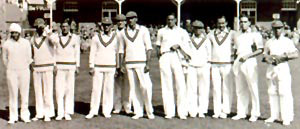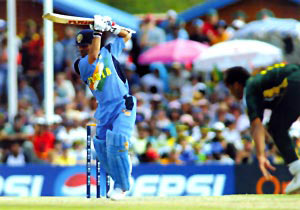History of Indian Cricket
>> Friday, January 15, 2010
Cricket is undoubtedly one of the most popular sports in India and the game is being played all over the country, since its inception. The exact day, month or year of Cricket`s inception in India is still shrouded in mystery, as nobody knows about it. However, according to some people, the Indians started playing the game for the first time in an organized way in the year 1848. The first Indian Cricket club named the Parsee Oriental Cricket Club was founded in that year and they played their first match in Bombay (Mumbai). Thus Cricket started its journey in India. Hence, the history of Indian Cricket can be identified as quite an old one.
However, according to some other, the history of Indian Cricket started its journey in the place named Sylhet (located in today`s Bangladesh). A clear evident has been found to prove this and it is a match report published in the Sporting Intelligence magazine, on 3rd March, 1845. The report was published by the editor of the Englishman newspaper and the news item was titled as "Sepoy Cricketers". The reporter actually gave a wonderful commentary of a match played between the European cricketers and the Sepoy cricketers. Apart from this news item, another report has been found to support the fact that Cricket was first played in Sylhet in India. This report was titled as "Sepoy Cricket at Sylhet" and in this report, the reporter wrote about the match between two regimental sides, each of which contained at least eight native cricketers. The reporter also termed the match to probably be the best contested encounter of that particular season. He also declared that "as usual the bowling of Sepoy Soophul was first rate...".
After its inception, Cricket started to get popularity among the Indian people within a short period of time. The middle and last half of the nineteenth century was an important period in the history of Indian Cricket, as the game spread its reach in almost all the parts of India during that period. Many teams from England started touring India by the close of the nineteenth century. There is a report published in the newspaper, `The Times of India` that supports this fact and the report was about the Presidency matches between the Parsees and the Lord Hawke`s Englishmen. The match was held in Bombay in 1892. The report described how the international Cricket matches that took place in Bombay at that time, increased interest among the local people. In the Metro cities of India like Calcutta (Kolkata), Bombay (Mumbai) and Madras (Chennai), Cricket was started to be played by the first half of the twentieth century. As the Hindus of India too started playing the game, the tournament of Bombay Presidency Matches became the Bombay Triangular in 1907-08. In 1912-13, the entry of the Muslims made it a quadrangular. Though India did not have a national cricket team during the early 1900s, a few Indian great cricketers of that era did represent the England cricket team. Ranjitsinhji and Duleepsinghji were the prominent ones among them. However, the first international exposure in the history of Indian Cricket came in the year 1926. In that year, a team from the Marylebone Cricket Club (MCC), led by A.E.R Gilligan toured India. Though it was an unofficial tour, the Indian people were quite interested and enthusiastic about the matches that MCC played during the tour. The legendary Indian cricket player, C. K. Nayudu played brilliantly during that tour and he also scored a century against the MCC side in Bombay. The tour was responsible to redefine the contours of Indian cricket. It ultimately spearheaded to the formation of the Board of Control for Cricket in India (BCCI) in the year 1928. India was accredited Test status by 1932, much before it got its Independence in 1947. India played against England in that year.
Though India did not have a national cricket team during the early 1900s, a few Indian great cricketers of that era did represent the England cricket team. Ranjitsinhji and Duleepsinghji were the prominent ones among them. However, the first international exposure in the history of Indian Cricket came in the year 1926. In that year, a team from the Marylebone Cricket Club (MCC), led by A.E.R Gilligan toured India. Though it was an unofficial tour, the Indian people were quite interested and enthusiastic about the matches that MCC played during the tour. The legendary Indian cricket player, C. K. Nayudu played brilliantly during that tour and he also scored a century against the MCC side in Bombay. The tour was responsible to redefine the contours of Indian cricket. It ultimately spearheaded to the formation of the Board of Control for Cricket in India (BCCI) in the year 1928. India was accredited Test status by 1932, much before it got its Independence in 1947. India played against England in that year.
After Independence, a big push came in the history of Indian Cricket, when India got its first ever Test series win against the neighbouring Asian counterpart and archrivals Pakistan, in 1952. The series saw brilliant and extraordinary performances from some of the greatest Indian Cricket players like Polly Umrigar, Vijay Manjrekar and leg spinner SM Gupte. The Indian Cricket during 1960s saw the Indian team becoming a formidable side on home soil. It was also the decade, when the Indian team started playing well in overseas. India`s great performances on home soil were evident from the fact that India defeated New Zealand and held the teams like Pakistan, England and Australia to a draw, during that period. The 1960s also saw the rising of some of the greatly talented Indian Cricket players like Mansoor Ali Khan Pataudi, Dilip Sardesai, Hanumant Singh, Chandu Borde and not least of all, off-spinner EAS Prasanna.
The era of India`s spin quartet comprising Bishen Singh Bedi (left-arm spinner), Erapalli Prasanna (off-spinner), BS Chandrasekhar and Srinivas Venkataraghavan (off-spinner) during 1970s, is considered as the golden era in the history of Indian Cricket. Apart from the dominance of the spin quartet over all the batsmen of the world, 1970s also saw the rising of two of India`s greatest ever batsmen - Sunil Gavaskar and Gundappa Vishwanath. All of these great Indian Cricket players made their presence felt in the international circuit and contributed immensely in the success of Indian team. India successfully won consecutive Test series in West Indies and England in 1971 and the team was led by Ajit Wadekar, in both the series.
 The decade of 1980s in the history of Indian Cricket, saw the Indian team getting significant success in the shorter version of the game, One-Day Internationals (ODIs). India won the World Cup for the first time in 1983, and it was also the only time that India has so far become the world champions. The Indian Cricket saw the rising of some more great cricketers like Kapil Dev, Mahinder Amarnath, Madan Lal, etc, during the 1980s, as well. The entire decade of 1990s in the history of Indian Cricket was dominated by only one cricketer, named Sachin Tendulkar. Sachin is still continuing his service to the Indian Cricket and is considered to be one of the greatest cricketers in the History of Cricket. With the help of Sachin, and some other great cricketers like Sourav Ganguly, Rahul Dravid, Anil Kumble, Javagal Srinath, the Indian team successfully won several Cricket Trophies in and outside India.
The decade of 1980s in the history of Indian Cricket, saw the Indian team getting significant success in the shorter version of the game, One-Day Internationals (ODIs). India won the World Cup for the first time in 1983, and it was also the only time that India has so far become the world champions. The Indian Cricket saw the rising of some more great cricketers like Kapil Dev, Mahinder Amarnath, Madan Lal, etc, during the 1980s, as well. The entire decade of 1990s in the history of Indian Cricket was dominated by only one cricketer, named Sachin Tendulkar. Sachin is still continuing his service to the Indian Cricket and is considered to be one of the greatest cricketers in the History of Cricket. With the help of Sachin, and some other great cricketers like Sourav Ganguly, Rahul Dravid, Anil Kumble, Javagal Srinath, the Indian team successfully won several Cricket Trophies in and outside India.
The new millennium brought a new era in the history of Indian Cricket, as the Indian cricket team has shown some wonderful performances during this period. India has so far won the ODI trophies like Natwest, The Champions` Trophy, the Mini World Cup, etc. The team also beat the Cricketing superpowers like Australia, South Africa, England, West Indies, Pakistan, etc. in various Test series. In the new century, the Indian cricket has found a great captain in Sourav Ganguly, who took the team to the Final of the World Cup, 2003 and also led the team in getting some other great successes. The team is currently being led by the young and enthusiastic MS Dhoni in both the ODIs and in Tests. Dhoni led India in winning the ODI series in Australia distinctively, and he also led the team in noticeable performances in the recently concluded Kit Ply Cup in Bangladesh and in the Asia Cup. With Ganguly and Kumble already retired from the international cricket, and Tendulkar and Dravid approaching to the finishing stages of their illustrious careers, the future of Indian cricket now lies in the hands of the younger but experienced players. Some of the most notable Indian Cricket players of this time include Virender Sehwag, Harbhajan Singh, Mohammad Kaif and Yuvraj Singh along with the rookies like S Sreesanth, Munaf Patel, Suresh Raina, Irfan Pathan, Gautam Gambhir, Yousuf Pathan, Manoj Tiwari, Manpreet Goni, Rohit Sharma, Pragyan Ojha, Piyush Chawla, apart from the very much enthusiastic captain, Mahendra Singh Dhoni.
0 comments:
Post a Comment